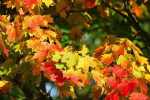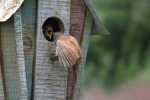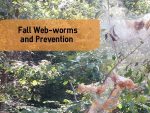Fall brings cooler weather, pretty leaves, and those horrible webs that seem to cover the trees and deter from the pretty leaves. Commonly referred to as bagworms or webworms. Hyphantria cunea are the type of webworms that make their appearance during late summer and autumn. Webworms should not be mistaken for bagworms there are in fact two separate worms that spin webs. Webworms make those large ugly nests. Bagworms on the other hand disguise themselves as leaf debris and the female hangs from the tree in a cacoon. Now that we know what a webworm is how do we go about webworm prevention?

The Good News
The good news is that webworms don’t generally hurt the tree and are just more of an aesthetic problem. Webworms only munch on the leaves of the tree. Since fall is fast approaching when webworms make their appearance known the trees are already about to go dormant for the winter.

The Bad News
The bad news is that webworms range from southern Canada across the U.S. and love just about every kind of hardwood tree. Hickory, oak, pecan, even redbud, and some fruit trees. The list goes on encompassing almost all deciduous trees.
Webworm Identification and Appearance
More than likely before the worm or adult moth is spotted we will notice the nest. Nests are composed of spider-like stringy thread that is woven together with twigs, leaf debris, and excrement from the worms. They gradually become larger and encompass more leaves, the larger nests can reach up to 3 feet.
The adult moth is most commonly white with darker spots on the wings.
Caterpillars can grow up to 1 inch long and colors vary by climate and location. Most caterpillars have a yellow to green colored body with a mottled strip or two running along the length of them. Their heads can range in color from black to a reddish hue.
Webworm Life Cycle

The eggs are laid on the underside of the leaves. Clutches contain a couple of hundred eggs that hatch out in about a week. Young caterpillars build their own webs while they feed on leaves. This stage will last about a month and a half. As winter comes closer the grown caterpillar weaves a dark brown cocoon about ⅜ of an inch long either in leaf debris or under some loose bark. It will survive the winter in its pupa form.
Webworm Prevention and Control
More often than not little is done to control these pests. Expert opinion is that they cause little damage to trees, that are preparing to shed their leaves and go dormant for the winter. So why not let them be.
Tree safety aside making your home in a tall tree and out of reach keeps most humans from braving the awkward scenario of removing them. But what if some of us do want to remove them from interrupting our fall leaf experience. Webworm prevention will speed up the webworm control process.

- Natural Enemies
Webworms have a lot of them. Including birds, if you can reach a web cut it open to give birds easy access.
Make Your Yard More Bird-FriendlyAdding bird feeders, houses and baths will help you attract mother nature’s first line of defense.
Keep Trees Pruned. Pruning dead branches will help deter them especially if you use pest spray afterward - Keep Debris Picked UP.
Leaf and other fall debris provide hiding places for insects and prevent natural predators from getting an opening.
Sevin Dust or other farm powder can be used as soon as you notice a problem and repeat 10-14 days later. The construction on the web makes nests water-resistant and prevents most sprays from penetrating. - Let them Be, remember a healthy complete ecosystem is always the best way to prevent pests and promote a healthy lawn and landscape.
Webworm prevention should begin earlier in the season with webworm control. Make sure you are treating for the correct worm. Try to pick out native plants when adding to your garden to help build up the native natural ecosystem. Native plants help build a stable diverse natural ecosystem to attract natural predators for most lawn and landscape pests.
